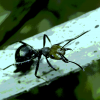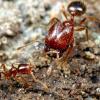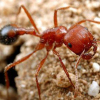As dboeren mentioned. Dubia roaches are less smelly and noisy than crickets and very easy to breed and is considered better nutritionally. Basically less upkeep than crickets and not as noisy. They also can store uric acid from protein sources, thus have a higher concentration to use if needed later, which is good for Camponotus as there's discussion that this may be important to their health. There's many tutorials out there on youtube.
My colonies least favorite insect is also mealworms and you'll find many other antkeepers say the same, so it's not uncommon. It really depends on your ants. There is a sticky for ants favorite foods but that is also personal experience but usually there are some feeders that are more consistently accepted more than others. I've found they prefer soft bodied insects.
Personally this is what I would do, depending on your colony size.
1. Dubia roaches
I'm breeding them and they are very easy to breed but in 6 months you'll have too much unless you have large colonies, so you may not want to breed them right way. Do note it takes bout 4-5 months for Dubias to mature to be able to breed, so unless you have adults(which you can just get a 12 dollar 5 male, 10 female on amazon), keep that in mind. My Myrmecocystus placodops is at about 200 workers and 50 workers respectively and I couldn't use all of 25 small roaches in 3 months as part of my rotation, which is fruit flies, Dubia roaches, mealworms. Make your own roach chow, there's many videos out there but the gist is you don't want to feed them too high of a protein diet. 12% and under is easier to find. There was a interview with a researcher on Dubia roach diet and he actually mentioned 5% is ideal. This however applies to diet for feeding reptiles, not sure how ants may react to roaches with high stores of uric acid(they store it from protein for later use) from a higher protein diet. You can always freeze extra however or just give it away to friends.
I've found my colonies do prefer freshly killed insects at my current size, but perhaps they may be less picky when they have more numbers, that's usually the case. When I kept Pogonomyrmex they pretty much took anything and everything, My Myrmecocystus is a bit pickier. My colonies like but not love Dubia roaches . My Camponotus takes and stores everything except mealworms.
2) Fruit flies
Easy to culture. Only drawback is they may introduce grain mites, which can be an eyesore. I've never had that problem. Hydei is a larger option. My colonies never refuse fruit flies.
3) Mealworms
Least favorite of my ants but they do occasionally drag them back to the nest. They do slurp up the juices but is the least popular feeder they drag back. I mostly see them drag it directly to the trash bin. Tried feeding the pupae cut up and straight to trash.
These are cheap and easy to keep for long periods. Put in fridge and use carrots for water. I also put a small vial of water with cotton for them and keep in fridge. Once a week just take them out for up to 24 hours so they can feed on whatever food bedding(wheat germ is preferred) you use and for them grow a bit. I bought my mealworms small and they did not seem to have much meat when I fed them because I wasn't taking them out weekly for them to feed. I found this out through later research. I've had my 100 count mealworms since April and still haven't used them up. They are quite large now.
4. Crickets
I occasionally bought crickets but will not anymore. I'd just freeze crickets if you do decide to get some as a treat as they appear to store well in freezer. They're cheap enough and available locally. They are similar to Dubia roaches as far as preference from colonies.
4. wild caught --> termites, spiders, blue bottle fly, honey bees
They never refuse termites, spiders, and honeybees. They always drag them into the nest right away. Have only fed blue bottle fly once so far and they dragged it in right way. You can also raise these but blue bottle flies are probably the more practical option to raise. When they hatch just put in freezer to slow them down and feed what you need. I have a few more frozen. I'll see if they take frozen blue bottle flies as readily. Would be great if there was a wingless or flightless version of larger feeder flies.
I wish there was a feeder spider. It would be difficult as most spiders would cannibalize each other thus would require more upkeep. I looked into social spiders but they are not easy to find at least in California.
If your colony takes in frozen insects that is the most practical. I'm sure larger colonies may be less picky when they have more mouths(larvae) to feed.
On a practicality level I decided on:
Dubia roach --> breed them
Fruit flies ---> breed them
Mealworms ---> keep in fridge and take them out once a week to feed. Lasts many months.
occasional option:
Crickets ---> store in freezer
I prefer not to use wild caught but if a spider, fly, honeybee is seen, it's flash frozen in the freezer and fed.
To illicit and observe good feeding responses, you can feed them protein less often(twice a week).I feed protein every other day or sometimes 5 days a week but I feed smaller portions. My buddy feeds twice a week, sometimes less and his colonies are thriving. His Myrmecocystus navajo colony at the time perhaps 600-800 workers takes down live crickets, leaf hoppers, spiders, with ease and is ferocious.
Edited by Mushu, August 13 2024 - 4:36 AM.





















